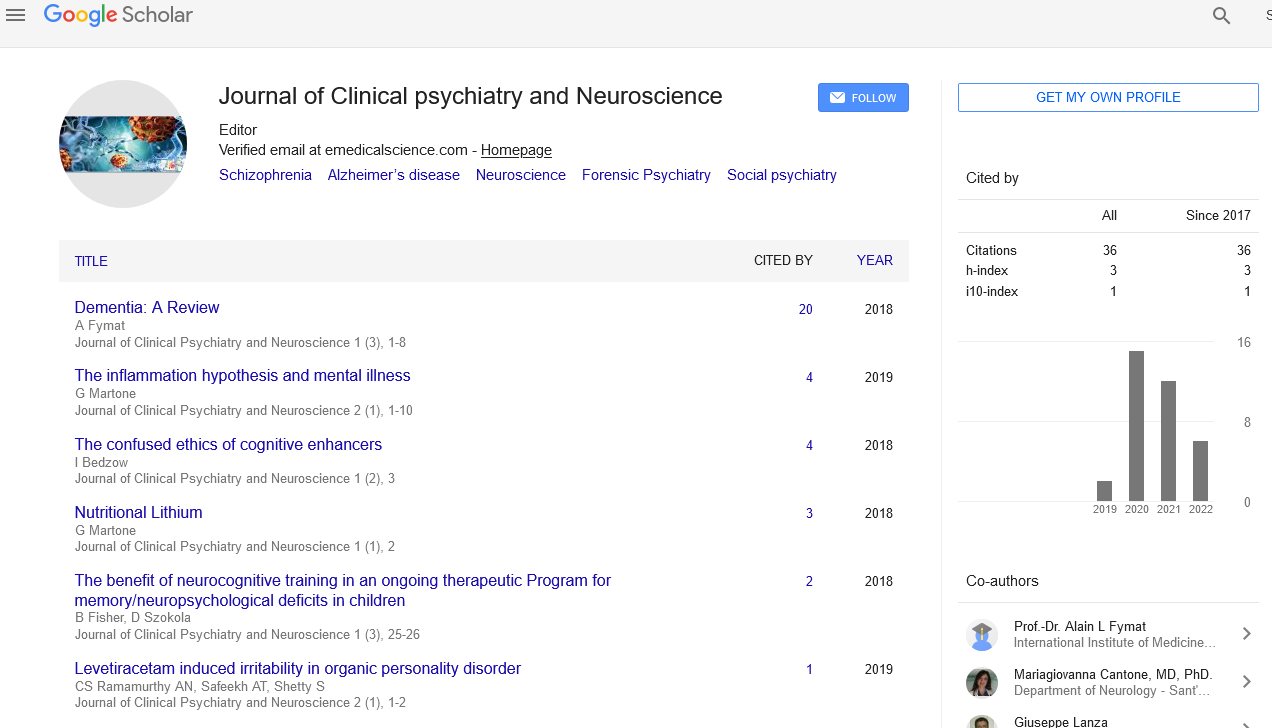Mental health and chronic diseases
Received: 02-Mar-2022, Manuscript No. PULJCPN-22-4875(M); Editor assigned: 04-Mar-2022, Pre QC No. PULJCPN-22-4875(PQ); Accepted Date: Mar 26, 2022; Reviewed: 20-Mar-2022 QC No. PULJCPN-22-4875(Q); Revised: 22-Mar-2022, Manuscript No. PULJCPN-22-4875(R); Published: 28-Mar-2022, DOI: 10.37532/ puljcpn.2022.5(2).17-18
Citation: Malan F. Mental health and chronic diseases. J Clin Psychiatry Neurosci. 2022; 5(2):17-18.
This open-access article is distributed under the terms of the Creative Commons Attribution Non-Commercial License (CC BY-NC) (http://creativecommons.org/licenses/by-nc/4.0/), which permits reuse, distribution and reproduction of the article, provided that the original work is properly cited and the reuse is restricted to noncommercial purposes. For commercial reuse, contact reprints@pulsus.com
Abstract
A mental disorder (such as depression, anxiety, or bipolar disorder) may be classed as related to another medical ailment in modern psychiatric classification systems. This diagnosis is given when evidence from the history, physical examination, or laboratory data indicates that the disturbance is the direct pathophysiological consequence of another medical disease, according to DSM-5. This method has an inherent flaw: by definition, a descriptive classification system should not take into account the disorder's aetiopathogenesis. The diagnosis is, in fact, the result of aetiopathogenic criteria (the disorder is due to a general medical condition).
Keywords
Mental health; Psychiatry; Anxiety; Psychiatric disorder
INTRODUCTION
Co-morbidity with a mental illness, on the other hand, implies the presence of another chronic condition in a way that cannot be overlooked. Regardless of the various and unique pathways that can lead to a mental disorder before (as first onset syndrome), during, or as a result of another chronic disease, mental diseases can impact compliance with the other disease's treatment. Drug interactions may occur as a result of treatment for these co-morbidities. Biorhythms may be affected by the conditions, affecting compliance and consequences. As a result, underlying vulnerabilities to mental diseases, whether biological, genetic, or social, must be considered not only when studying the etiology of co-morbidities, but also when developing treatment strategies. Corticosteroids, for example, have been shown to cause mood disturbances in patients with Multiple Sclerosis or Rheumatologic Diseases. It is also clear that the course of a mental condition in co-morbidity with another chronic disease differs from the course of a similar problem in the absence of co-morbidity. In many chronic diseases, the coexistence of a disorder like depression is a major determinant of disability and poor quality of life, and it has been proven that unless both conditions are treated at the same time, treatment response is likely to be poor.
All of this contrasts with the fact that the majority of clinical trials on the efficacy of treatments are conducted with criteria that exclude patients with co-morbidity, and that only a few studies have focused specifically on the conditions in which a mental illness coexists with another chronic disease, despite the fact that, in many chronic diseases, the coexistence of a disorder like depression is a major determinant of disability and poor quality of life. The magnitude of these events necessitates a renewed focus on the issue of co-morbidity. Wilson Disease is a rare genetic condition that causes copper buildup in many organs, including the liver and brain. Researchers explain why psychiatric problems (particularly depressive and bipolar disorders) are a major diagnostic and therapeutic dilemma in Wilson Disease, contributing to reduced Quality-of-Life and poor therapy adherence. Therapeutic adherence is maintained with good clinical follow-up employing a multidisciplinary approach, as well as education about hazards in persons affected and their relatives, and therapies for this condition lead to a decent life expectancy.
Cardiovascular illness is a serious public health concern, and it is usually associated with psychiatric (particularly mood) issues. Patients with cardio-vascular diseases and mood problems have a high rate of impairment and mortality, according to scientists. The authors show that these connections are bidirectional because of a common genetic risk of pathways implicated in stress reactions, such as serotonin or dopamine signaling. Patients with cardio-vascular diseases should be routinely evaluated for the existence of mental disorders, as they rightly propose. To prevent cardio-vascular diseases, people with mood disorders should receive behavioral lifestyle interventions focusing on nutrition and exercise, coping methods, and health information on a regular basis.
The investigations on the link between psychiatric problems and celiac disease have also been summarized by the researchers. Coeliac disease is the most frequent autoimmune lifelong ailment in Western nations (affecting more than 1% of the population), with symptoms including diarrhea, weight loss, and anemia. Comorbidity in psychiatry can make diagnosis difficult, which can lead to low quality of life. This co-morbidity may make it more difficult to stick to the gluten-free diet, which is the most important treatment in the early stages of the condition. As a result, screening for psychological disorders is necessary and recommended in celiac disease.
Finally, scientists' contributions cover epidemiology, pathophysiology, genetic and environmental factors, temporal connection, therapy choices, and screening issues associated to Migraine and Major Depressive Disorder. This is a very prevalent comorbidity that causes severe disability. Although there is evidence of bi-directional causality, more research, including longitudinal studies and brain imaging studies, is needed to fully comprehend the pathophysiology.
CONCLUSION
We believe we have demonstrated, in the specific fields addressed as models, how this field necessitates the most advanced techniques (from brain imaging to genetic research), as well as clinical synthesis skills that can apply advanced knowledge to a person's specific need through a user-centric approach. Furthermore, because early diagnosis and screening are critical in the majority of these illnesses, it is clear that no translational component may be overlooked. All of this points to a road that must go beyond previously held beliefs, one in which simplifications might be destructive.





